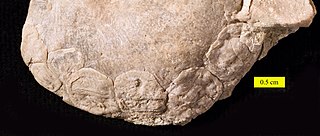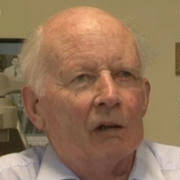
Thomas Davidson was a British palaeontologist.
Dolerorthis is an extinct genus of hesperorthid brachiopod. The type species of this genus, D. interplicata, was described from the Silurian (Telychian) Osgood Formation. Other species belonging to this genus are known from the Ordovician and Silurian of Europe, Kazakhstan, China and Argentina. It was roughly 4 centimetres (1.6 in) across.

The Craniidae are a family of brachiopods, the only surviving members of the subphylum Craniiformea. They are the only members of the order Craniida, the monotypic suborder Craniidina, and the superfamily Cranioidea; consequently, the latter two taxa are at present redundant and rarely used.There are three living genera within Craniidae: Neoancistrocrania, Novocrania, and Valdiviathyris. As adults, craniids either live freely on the ocean floor or, more commonly, cement themselves onto a hard object with all or part of the ventral valve.
Kingena is an extinct genus of primarily Cretaceous-aged brachiopods of the family Kingenidae whose fossils are found in marine strata of Antarctica, Europe, and New Zealand. Early Paleocene-aged fossils from Denmark represent the youngest species.

The origin of the brachiopods is uncertain; they either arose from reduction of a multi-plated tubular organism, or from the folding of a slug-like organism with a protective shell on either end. Since their Cambrian origin, the phylum rose to a Palaeozoic dominance, but dwindled during the Mesozoic.

Leonard Robert Morrison Cocks, OBE, TD, known as Robin Cocks, was a British geologist, formerly Keeper of Palaeontology, Natural History Museum. He was best known for his work on brachiopods, and their use in reconstructing Earth history and past ecosystems.
Leonard Frank Spath FRS was a British geologist specialising in malacology and ammonitology.
The Palaeontographical Society is a learned society, established in 1847, and is the oldest extant Society devoted to the advancement of palaeontological knowledge.

Musculus somaliensis is an extinct species of small saltwater mussel, a fossil marine bivalve mollusc in the family Mytilidae, the mussels. The size, shape and sometimes color of these fossils are reminiscent of a pistachio nut.

Somalirhynchia africana is a species of extinct, medium-sized brachiopod, a marine rhynchonellate lampshell in the family Tetrarhynchiidae. It is roughly the size and shape of a 1-inch (25 mm) toy marble, and has about 29 ribs fanning out from the hinge.

Rhynchonelloidella smithi is a species of extinct, small-sized brachiopods, a marine rhynchonellate lampshell in the family Rhynchonellidae. It is roughly 9/16 inch (1.4 cm), and has about 21 ribs fanning out from the hinge.
Wilfred Norman Edwards FGS was a British paleobotanist and keeper of geology at the Natural History Museum from 1938 to 1955 and was awarded the Lyell Medal in 1955.

The Charmouth Mudstone Formation is a geological formation in England, dating to the Early Jurassic (Sinemurian–Pliensbachian). It forms part of the lower Lias Group. It is most prominently exposed at its type locality in cliff section between Lyme Regis and Charmouth but onshore it extends northwards to Market Weighton, Yorkshire, and in the subsurface of the East Midlands Shelf and Wessex Basin. The formation is notable for its fossils, including those of ammonites and marine reptiles and rare dinosaur remains. The formation played a prominent role in the history of early paleontology, with its Lyme Regis-Charmouth exposure being frequented by fossil collectors including Mary Anning.

Sydney Savory Buckman was a British palaeontologist and stratigrapher. He is known for his studies of extinct marine invertebrates, especially the Brachiopoda and Ammonoidea of the Jurassic era.

Linoproductus is an extinct genus of brachiopod belonging to the order Productida and family Linoproductidae. Specimens have been found in Carboniferous to Permian beds in Asia, North America, and South America.

Marginifera is an extinct genus of brachiopod belonging to the order Productida. Specimens have been found in Carboniferous to Triassic beds in Asia, Europe, Madagascar, and North America.
Gertruda Józefa Biernat was a Polish geologist and paleontologist. During World War II, she joined the Polish resistance, participating in the Warsaw Uprising. She is noted for her work in identifying and studying brachiopods of the Ordovician period of the Paleozoic Era, and several have been named in her honor. Biernat worked at institutions of the Polish Academy of Sciences, published major works on brachiopods, participating in paleontological expeditions internationally, including leading a series of expeditions in the Arctic.
Pustula is an extinct genus of brachiopods which lived during the Carboniferous period. It is the type genus of the subfamily Pustulinae. Its fossils have been found in Eurasia, North America and northern Africa.
Pulchratia is an extinct genus of brachiopods which lived in marine habitats during the Upper Carboniferous period. Its fossils have been found in North America.











